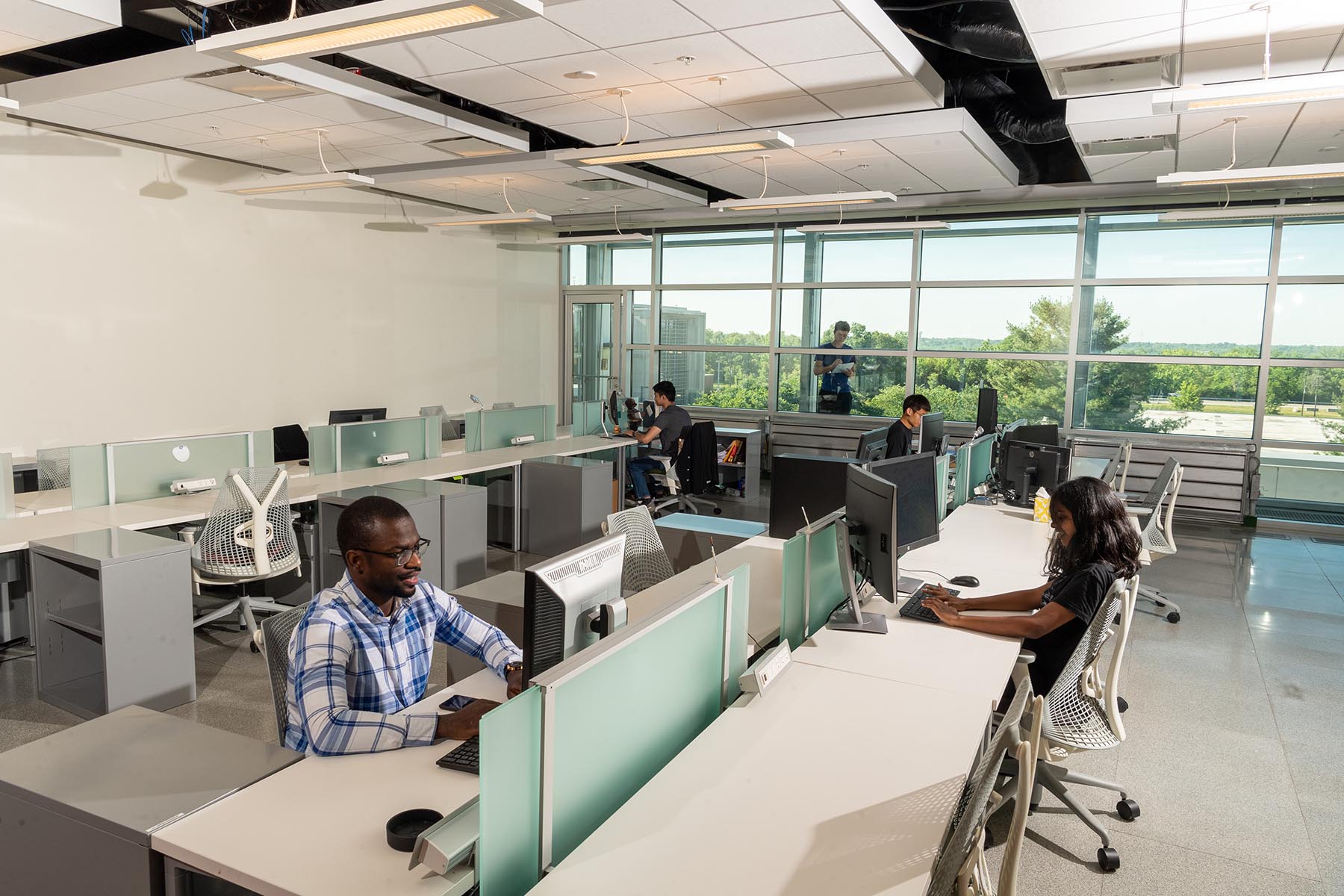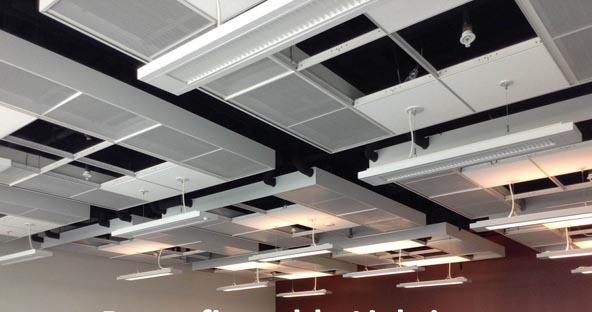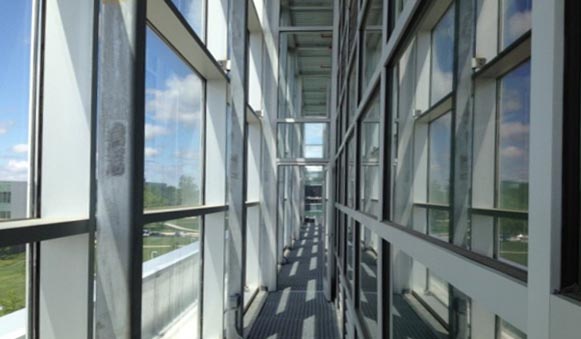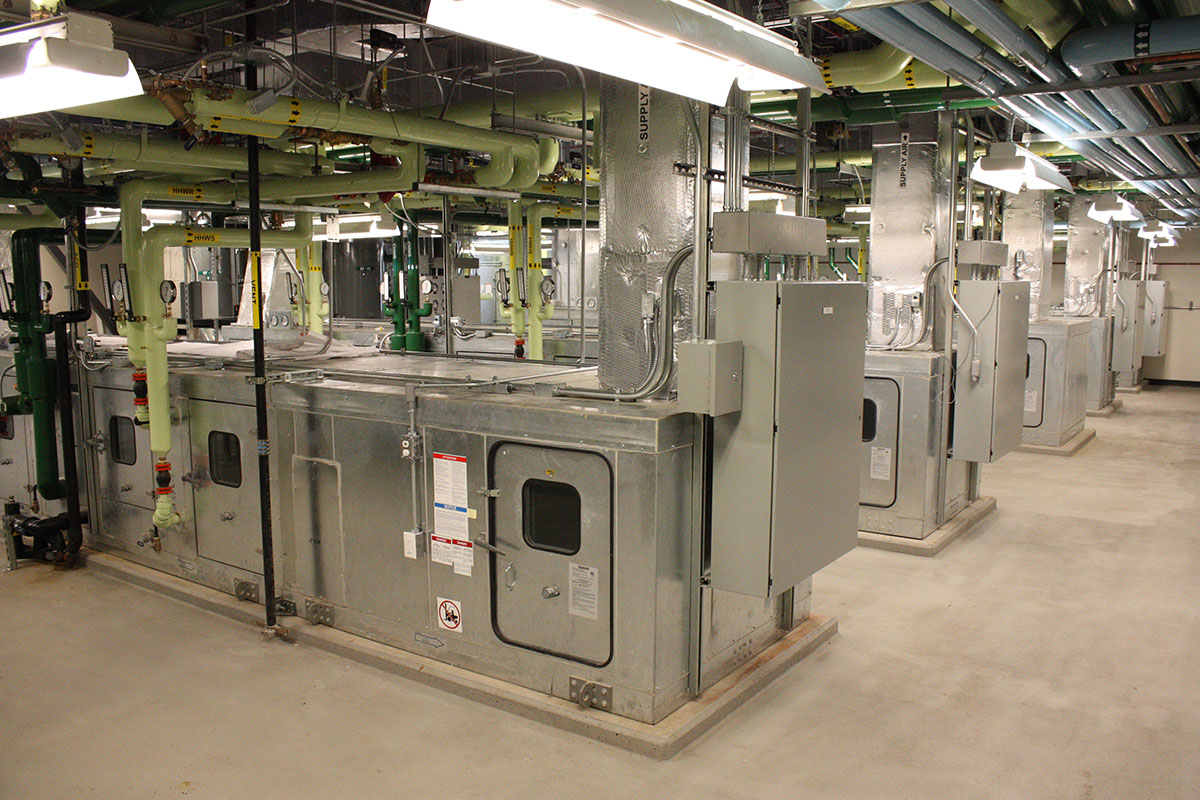Herrick's "Living Labs" are where innovation lives
You don't typically think of your home or workplace as a "laboratory" (unless you are a scientist!). But have you ever wondered about the brightness of the lights, or the temperature settings in your workplace, and why they were determined to be ideal? Behind the scenes, researchers are studying what keeps us comfortable and safe while we are indoors – from the heating and air-conditioning systems, to airborne particulates, to the best place to sit in the room. All of these are studied at a one-of-a-kind facility at Purdue University’s Ray W. Herrick Laboratories.

A Living Laboratory Like No Other
Launched in 2013, the Herrick Living Labs were designed from the ground up to function as real, occupied environments that double as precision-controlled experimental testbeds. Located inside Herrick's LEED-Gold certified building, the four side-by-side open-plan offices house students and researchers as full-time occupants, who simultaneously serve as test subjects. The goal? To study how humans interact with their environment under authentic, day-to-day working conditions—something rarely achievable in most laboratory settings.
“We are conducting research with human subjects under real working conditions, which is hard to find—and this is the strength of these labs,” says Thanos Tzempelikos, Professor of Civil and Construction Engineering. These four labs, each roughly 1,300 square feet, feature completely independent and customizable controls for temperature, humidity, lighting, air distribution (via ceiling, walls, or floor), acoustics, and envelope characteristics. From adjustable curtain walls for natural ventilation studies to dimmable electric lighting and automated window shades, the labs allow for fine-grained environmental manipulation while collecting massive amounts of data—more than 1,000 sensors continuously monitor occupant comfort, building performance, and energy use.

Panagiota Karava, Professor of Civil and Construction Engineering, speaks to the key amenities of the Living Labs and the contribution toward the Perception Based Engineering Lab by noting “The uniquely designed reconfigurable elements such as the hydroponic floor with 10 individually controlled loops and individually controlled ceiling diffusers enabled novel research on AI-enabled self-tuned indoor environments that led to the development of the new human-building interactions lab (within Herrick’s Perception Based Engineering Lab).”

What Makes Herrick’s Living Labs Unique
Kevin J. Kircher, Assistant Professor and researcher for the Center for High Performance Buildings notes the unique qualities our labs offer, “The four living labs present unique opportunities to test equipment and software simultaneously in nearly identical spaces. This enables rigorous A/B testing that is difficult to arrange in most buildings, where testing is typically done sequentially in the same space but under potentially different weather and occupancy conditions. The living labs are also occupied by enthusiastic and knowledgeable students, which enables uniquely participatory, occupant-centric approaches to controlling the indoor environment.”
|
Capability |
Herrick Living Labs |
Typical University Lab |
|---|---|---|
|
Real-time research with occupants |
+ |
x |
|
4 parallel, mirrored test chambers |
+ |
x |
|
Fully customizable airflow and façade |
+ |
|
|
High-resolution VOC, O, and CO monitoring |
+ |
|
|
Integration of thermal, acoustic, lighting, and IAQ control |
+ |
|
|
Dynamic envelope studies (windows, daylight, ventilation) |
+ |
|
Herrick’s labs are not just test environments—they are flexible ecosystems for interdisciplinary collaboration, bringing together mechanical engineers, civil engineers, psychologists, public health researchers, and data scientists. Whether studying thermal comfort, virus-laden aerosols, or productivity under dynamic lighting, the labs provide an unparalleled experimental platform.

Critical Findings That Shape the Future of Buildings
A few of the Living Labs' most significant contributions lie in indoor air quality (IAQ) research. As a researcher who devotes much of his time to IAQ, Brandon E. Boor, Dr. Margery E. Hoffman Associate Professor in Civil Engineering, conveys “The Living Laboratories provided an excellent setting to examine how occupant behavior and HVAC system operation influence the chemical composition of indoor air.”
A landmark 2025 study by Brandon Boor, including Jinglin Jiang, Junkai Huang, and Nusrat Jung explored how ozone (O) and carbon dioxide (CO) concentrations vary within an HVAC system of a LEED-certified office.
Key Findings:
- Outdoor air exchange rates (AERs) play a dominant role in controlling indoor ozone levels.
- Occupants themselves act as ozone sinks, with skin and clothing absorbing a significant amount of indoor ozone.
- Standard HVAC setups may fail to address these dynamics without occupancy-aware ventilation strategies.
Another study done in 2021 by Satya Patra, Tianren Wu, Danielle Wagner, Jinglin Jiang, and Brandon Boor focuses on real-time measurements of fluorescent aerosol particles (FAP) in a living lab office space under variable occupancy and ventilation conditions.
Key Findings:
- Human occupants were identified as a major source of super-micron FAPs in mechanically ventilated office buildings, as office occupants were strong emitters of specific types of particles types are related to common indoor bacterial and fungal aerosols and fluorescent clothing fabric fibers.
- The introduction of natural ventilation through a double skin glass facade increased the indoor abundance of FAPs due to the efficient transport of outdoor FAPs into the office.
In 2019, a Purdue Living Labs-based study by Tianren Wu, Danielle Wagner, Hjinglin Jiang, Philip Stevens, Heinz Huber, Antonios Tasoglou, and Brandon E. Boor, was submitted to the American Association for Aerosol Research AAR 37th Annual Conference titled, “Dynamics of Volatile Organic Compounds (VOC) in a Living Laboratory Office and HVAC System.
Key Findings:
- Humans are a prominent source of VOCs in occupied spaces (Human-associated VOC emissions include exhaled breath, skin secretions, personal care products, ozone-skin oil reaction products, clothing, and microorganisms), increasing with higher occupancy.
- VOCs relating to personal care products such as deodorants were at the highest concentration in the morning and decrease throughout the day, and metabolic activity reached peak concentrations in mid-afternoon.
- The primary reduction for indoor VOCs is ventilation, with the reduction rate increasing through increased outdoor air exchange rates.
A Track Record of Research Excellence
Since 2013, the Living Labs have become central to Purdue’s national and international leadership in sustainable and intelligent building design. The labs have supported over a dozen major grant-funded projects, including: NSF (National Science Foundation), DOE (U.S. Department of Energy), CHPB (Center for High Performance Buildings), Lutron Electronics and Arconic Inc., among others.
“The world-class features of the Living Labs helped us secure three large NSF grants on cyber-physical systems for buildings and additional industry support totaling more than $4M.” adds Panagiota Karava, Professor of Civil and Construction Engineering.
This support underscores the labs’ value in enabling translational research—transforming experimental findings into practical design guidelines, smart HVAC controls, and next-generation building systems.
Where the Research Is Heading
Purdue’s Living Labs enable new research collaborations across engineering and social science schools and have been the testbed for more than 15 highly cited research papers being published, as indicated by Dr. Karava. The labs are further evolving by focusing on:
- Adaptive, occupant-specific thermal systems (e.g., wall-embedded radiant panels that personalize comfort)
- Autonomous building diagnostics and fault detection
- Smart energy storage integration with HVAC systems
- Human-centric lighting and acoustics
- Aerosol tracking for disease transmission studies
- Design principles for modular, deployable space habitats
Research conducted in the Living Labs by Thanos Tzempelikos, Professor of Civil and Construction Engineering, James E. Braun, Professor of Mechanical Engineering, and Janghyun Kim, explored the energy savings potential of a passive chilled beam model versus air systems in various US climatic zones. The unique set up of the labs would allow the researchers to conduct parallel studies, one using passive chilled beams and the other in an adjacent identical office space equipped with an air system and then compare the resulting energy consumption of the two. Essentially, the results of the study would support the impacts retrofitting existing spaces new technology.
“I think it would be interesting to develop and test technologies that allow thermal control to be tailored more specifically to individual preferences, such as small, modular, AI-controlled heat or cooling sources at the level of a desk space or even a chair.” adds Kevin J. Kircher, Assistant Professor of Mechanical Engineering.
These advancements are not speculative—they are being implemented in projects across the U.S. and beyond. The labs are informing the design net-zero office buildings, and modular healthcare environments, while also influencing how we think about comfort and energy use on Earth and in space. Dr. Karava shares, “A new software tool AI-enabled building energy expert for small to medium size commercial building is being validated using the Living Labs and a patent is in preparation with interest from several industry partners.”
The Future of Built Environments, Now
Purdue's Herrick Living Labs are more than just research spaces—they're living, breathing ecosystems that simulate and shape the future of human interaction with the built environment. Their realism, flexibility, and precision offer a rare trifecta in building science.
By bridging engineering, architecture, health, and sustainability, the Living Labs are transforming not only how we study buildings, but how we design them to serve people better.
Citations
- Jiang, J., Huang, J., Jung, N., and Boor, B.E. (2025). Spatiotemporal Variations in Ozone and Carbon Dioxide Concentrations in an HVAC System of a LEED-Certified Office Building. Building & Environment, 74:112651. https://doi.org/10.1016/j.buildenv.2025.112651
- Patra, S.S., Wu, T., Wagner, D.N., Jiang, J., and Boor, B.E. (2021). Real-Time Measurements of Fluorescent Aerosol Particles in a Living Laboratory Office Under Variable Human Occupancy and Ventilation Conditions. Building & Environment, 205:108249.https://doi.org/10.1016/j.buildenv.2021.108249
- Wu, T., Wagner, D., Jiang, J. Stevens, P., Huber, H., Tasoglou, A., Boor, B.E. (2019). Dynamics of Volatile Organic Compounds in a Living Laboratory Office and HVAC System. https://aaarabstracts.com/2019/viewabstract.php?pid=771
- Kim, J., Tzempelikos, A., and Braun, J.E., Energy Savings Potential of Passive Chilled Beams vs Air Systems in Various US Climatic Zones with Different System Configurations, Vol. 186, Pages 244-260, Energy and Buildings, 2019. https://www.sciencedirect.com/science/article/pii/S037877881832067X
Writer: Kimberly Daly, hitzek@purdue.edu
